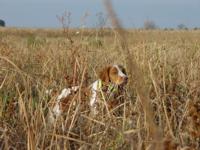 It was a very warm August afternoon when I came to a startling revelation; I had just wasted four plus years of my life on a dog that just couldn’t compete. Now don’t get me wrong, Sam is a fine dog but she wasn’t the dog that I thought I had been training or should I say would be the result of my training. It was a very warm August afternoon when I came to a startling revelation; I had just wasted four plus years of my life on a dog that just couldn’t compete. Now don’t get me wrong, Sam is a fine dog but she wasn’t the dog that I thought I had been training or should I say would be the result of my training.
My dog was the one that we trained for Shoot-To-Retrieves and Hunt Tests to hone her skills for the fall hunting season. The dog I actually had was one that always ended up in the middle of the pack at the Shoot-To-Retrieves and was the “other dog” when hunting in the fall.
In the various events that Sam ran in she was never better than seventh but never worse than twentieth out of thirty two dogs and the prospects for her breaking that streak in the coming season where not good. I decided that the event over the coming weekend would be her last and she would be relegated to light training and fall hunts. Little did I know what was going to happen in the coming months.
Sam was something of a special pup. We had been on a waiting list for four years to get a female pup from this particular frozen semen litter. After one false alarm, we got that call that the pups had been born and that ours would be ready in about eight weeks.
As the master of all bad timing played out, we were dealing with our oldest dog having GME and slowly losing control of the right side of her body. GME is a catch-all name for a type of encephalitis (swelling of the brain) which is caused by the body’s immune system slowly eating away at the brain. In short, Maggie was dying and there was very little we could do about it. Bringing a pup into the situation was about the last thing on our minds but we also couldn’t pass up this opportunity.
Sam came to us in a blaze of glory. She was kind enough to throw up six separate times in her kennel on the one hour drive home. When she walked into the house, she decided that she would be in charge, which just wasn’t going to work very well with our other three dogs.
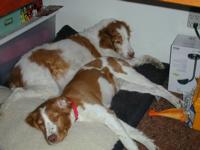 Sam took to Maggie, our sick dog, right away. She would be in full butt-tucked zoom mode and see Maggie lying under my desk. She would stop and get as close as possible to her and just lay there. I’m not real sure how Maggie felt about this, but they seemed to have something of a special bond. Sam took to Maggie, our sick dog, right away. She would be in full butt-tucked zoom mode and see Maggie lying under my desk. She would stop and get as close as possible to her and just lay there. I’m not real sure how Maggie felt about this, but they seemed to have something of a special bond.
When Sam was four months old, we had to put Maggie down; she had just degenerated too far to be comfortable anymore. This was especially hard on me since Maggie was really “my” dog. We had a strange kind of bond where she just knew what I wanted her to do and I rarely had to give her any type of command whether we were at home or in the field. It was a pretty rough day for all in the household.
I noticed a difference in Sam very shortly after that day. She started spending much more time with me. She would come and just hang-out, much like Maggie did. It seemed as if the torch of watching over me had been passed on to her.
After much discussion and a realization that Sam was going to be oversized (she was actually bought to be a “show dog”) we decided that some field training would be a good thing to do. We had an eight year old female at the time that we wanted to work in hunt tests, so this would work out quite well.
We met with a trainer and ran through some really basic stuff. I had done some hunting with Maggie, but the only thing I got out of her was what came naturally to her. I had no idea how to train a pointing dog for field work. This would work out well as Sam had no idea how to be a pointing dog. Fortunately for both of us, she was a fast learner at least in most respects.
Sam didn’t have a strong hunting drive. We started her on fresh dead birds. She had very little interest in them other than to try to pluck them. We tried birds in mechanical releases, no go. Sam would just run up to the release, look down with a “sucks to be you” look and continue on her merry (if you’ve ever seen a Brittany pup you completely understand what I’m talking about here) way. Needless to say, frustration was mounting just a bit. Our big breakthrough came one day when we just put out a couple of live birds and sure enough she slammed on point.
We still had the problem with getting Sam to run hard when she was in the field. She always seemed to have a very casual attitude about training. She never seemed to be in much of a hurry to get anywhere. We ran her with each of the trainer’s dogs on numerous occasions but only got marginal results. Sam was always last to the birds and still lacked intensity.
In a last ditch effort to light a fire under her, we took our eight year old female, Jessie, out with her. Jessie had taken over the top dog spot in the pack and if nothing else she would not allow Sam to screw around in the field. This was the magic combination that we were looking for. Sam came out and ran like a completely different dog. There was a fire in her that we hadn’t seen before.
A few weeks of running with Jessie proved to be enough and soon Sam would run hard all of the time. She began to get more competitive with her brace mates, although I did notice that she was still wasn’t first to the birds as often as the other dogs where. I kept telling myself that she was still young and that I shouldn’t worry about it.
Through all this, we had come to realize that Sam was extremely trainable. She would do what she was told and handle like a million bucks. However, there was still something missing in her that would not allow her to break into the “great dog” category and I just couldn’t put my finger on what it was.
During the next summer our trainer and his family took a trip to Alaska. While they were gone, I went out to his farm to run his dogs for him. There were three sets of his dogs and two sets of my dogs to run over the course of a couple hours. Sitting on a four-wheeler and chasing dogs through the fields for 20-30 minutes at a time allows you a great deal of time to think and observe. It was during that time that it hit me and it hit me hard, Sam ran wrong!
In watching the trainer’s dogs, they had a flowing pace to them. They would stretch and glide through the field while Sam looked like all four of her legs where going in opposite directions or at least weren’t making a coordinated effort to push her rather large body in the same direction. There was something in her body style that just plain limited her ability to run in a flowing and effortless way. She was expending twice the energy to run the same course. As a result, she would tire out more quickly than the other dogs. When she got tired, she became a far less effective a hunter.
This was a pretty devastating realization after three years of training. However, the analyst in me basically figured that she would simply need to be in better shape than the other dogs and that would take care of the problem. When spring arrived that is how we approached the problem; lots of running to go along with our bird work.
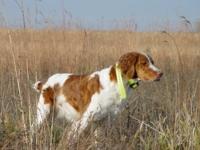 From March until August, we worked and worked. Five or six nights a week were spent running and running with an occasional bird work session tied in. After all, you can always work through a problem if you work hard enough at it. At least that was what I kept telling myself. From March until August, we worked and worked. Five or six nights a week were spent running and running with an occasional bird work session tied in. After all, you can always work through a problem if you work hard enough at it. At least that was what I kept telling myself.
About a week before the summer shoot-to-retrieve, we were running with one of the newer dogs that trained with us. Holly is a five year old Brittany that is from very good field lines. Although she had some different owners in the past, her current owner is committed to making her into a nice birddog.
When she first came to training, she wouldn’t get more than 50 yards away from us. She was extremely tentative and wary of everything going on around her. This condition lasted until she met Sam.
We brought Sam out with Holly during one of her training sessions and she seemed to figure out that it was alright to run and find birds. They became a very nice training combination. Sam initially ran the doors off Holly because she was in much better shape. It seemed that my plan was somewhat proving out and I was quite pleased with what was happening.
After a couple months of training (and a lot of conditioning), Holly started to pull away from Sam. While Sam still had the edge in handling her birds and handling in general, Holly was now blowing Sam’s doors off. She was first to the birds better than half the time. You could see Holly starting to really blossom.
While this was great for my training partner, it was very discouraging for me. As much as I had enjoyed the training with Sam, I honestly thought that our run of regular training was coming to an end. We would just be relegated to the occasional runs and some nice fall hunting.
As I got into the van that night after training I can clearly remember thinking and even telling my wife what a waste of time the last four years had been. It was probably the lowest point in my short time training dogs.
Our shoot to retrieve came and went and again we were in the middle of the pack. We kept the other dog honest with a couple of birds, but just couldn’t do any better than we had previously, new conditioning regimen and all.
As we prepared for some fall hunting, we got a phone call about a pup from a litter in Michigan. We had put a deposit on the litter months before, but we were way down the list for a female pup. The call came on Thursday that all four females had been taken and our search would have to begin again for a new pup. By Saturday we had gotten another call that one of the buyers had backed out and if we wanted there was a pup available and we could pick her up the following weekend at a field trail in Illinois.
We picked Abby up in Joliet, IL and made the seven hour drive back home. It had been a long time since Sam was a pup and I had forgotten just how tiny these little critters were. Sam was none to pleased by the new addition and made that point abundantly clear to the little dog immediately.
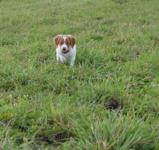 Abby is a really aggressive little dog, except in one way. She is really afraid to get out of the multi-kennel setup in the back of the van. She will just go to the back of the kennel and curl up in a ball so you can’t get her out. This was definitely going to be a problem. Abby is a really aggressive little dog, except in one way. She is really afraid to get out of the multi-kennel setup in the back of the van. She will just go to the back of the kennel and curl up in a ball so you can’t get her out. This was definitely going to be a problem.
After arriving home from training one day and getting the three older dogs into the house, I started working on getting Abby out of the kennel. It was a no-go. The thought then crossed my mind about using Sam to “show her” how easy this whole deal was. I let Sam back out of the house and opened Abby’s kennel. With a wave and saying “Sam kennel”, Sam hopped up into Abby’s kennel and then turned and came out. We did this about seven different times before Abby decided that it was not as difficult as she made it and she followed Sam out of the kennel.
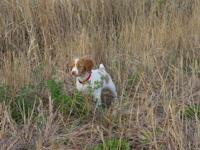 This moment was something of an epiphany for me. I came to realize exactly what the last four years of training had not been wasted. I had learned a lot about training dogs and was better equipped to have a high-energy racin’ chasin’ dog. But better yet, I also now had a four-legged assistant trainer to work with in training the new pup. An assistant that does everything I tell her to do and who handles her birds with the best of the other dogs out there. She doesn’t run so big as to intimidate her brace-mates but has a good enough nose to keep them honest. This moment was something of an epiphany for me. I came to realize exactly what the last four years of training had not been wasted. I had learned a lot about training dogs and was better equipped to have a high-energy racin’ chasin’ dog. But better yet, I also now had a four-legged assistant trainer to work with in training the new pup. An assistant that does everything I tell her to do and who handles her birds with the best of the other dogs out there. She doesn’t run so big as to intimidate her brace-mates but has a good enough nose to keep them honest.
Since that day, Abby has gotten quite a bit bigger and is now in the beginning stages of her hunting career. Sam is still out in front in the field, leading the charge and getting the puppy to run as hard as her tiny legs will carry her.
In the days to come, I fully expect that Sam will be the dog that helps to teach Abby how and when to honor and that whoa really does mean whoa. She will help to teach her about the horse trough where the dogs cool off after the long hot training runs and that you leave the farm animals alone, at least if you know what’s good for you.
Sam has taught me a great deal as well, but there is one thing that goes beyond the “how-to” and “why lessons”. She has taught me that there is no wasted time in dog training. You will learn something new every day and from every dog you work with. Sometimes you learn that you should have stayed home and watched the ballgame. Other times you learn that you really do need to believe your dog when they tell you there is a bird in front of them and “it’s right there”.
The bottom line in training is that no time is really wasted it’s just set aside for use in the future, whatever the future may bring. |

